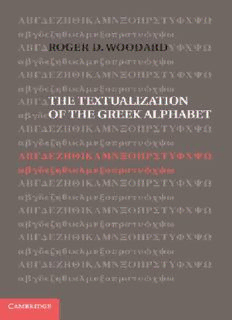
The Textualization of the Greek Alphabet PDF
Preview The Textualization of the Greek Alphabet
The Textualization of the Greek Alphabet In this book, Roger D. Woodard argues that when the Greeks first began to use the alphabet, they viewed themselves as participants in a performance phenomenon con- ceptually modeled on the performances of the oral poets. Since a time older than Greek antiquity, the oral poets of Indo-European tradition had been called “weavers of words” – their extemporaneous performance of poetry was “word weaving.” With the arrival of the new technology of the alphabet and the onset of Greek literacy, the very act of producing written symbols was interpreted as a comparable performance activity, albeit one in which almost everyone could participate, not only the select few. It was this new conceptualization of and participation in performance activity by the masses that eventually, or perhaps quickly, resulted in the demise of oral composition in performance in Greece. In conjunction with this investigation, Woodard analyzes a set of copper plaques inscribed with repeated alphabetic series and a line of what he interprets to be text, which attests to this archaic Greek conceptualization of the performance of symbol crafting. Roger D. Woodard is Andrew van Vranken Raymond Professor of Classics and Professor of Linguistics at the University of Buffalo (The State University of New York). His visiting positions have included appointments at the American Academy in Rome, Oxford University, the Centro di Antropologia e Mondo Antico dell’Università di Siena, the Max-Planck-Institut für Wissenschaftsgeschichte in Berlin, and the Max- Planck-Institut für evolutionäre Anthropologie in Leipzig. He is author or editor of many books, including Myth, Ritual, and the Warrior in Roman and Indo-European Antiquity; The Cambridge Companion to Greek Mythology; Indo-European Sacred Space: Vedic and Roman Cult; Indo-European Myth and Religion: A Manual; Ovid: Fasti (with A. J. Boyle); The Cambridge Encyclopedia of the World’s Ancient Languages; Greek Writing from Knossos to Homer: A Linguistic Interpretation of the Origin of the Greek Alphabet and the Continuity of Ancient Greek Literacy; and On Interpreting Morphological Change: The Greek Reflexive Pronoun. The Textualization of the Greek Alphabet Roger D. Woodard University of Buffalo David A. Scott With a chapter by 32 Avenue of the Americas, New York, NY 10013–2473, USA Cambridge University Press is part of the University of Cambridge. It furthers the University’s mission by disseminating knowledge in the pursuit of education, learning, and research at the highest international levels of excellence. www.cambridge.org Information on this title: www.cambridge.org/9781107028111 © Roger D. Woodard 2014 This publication is in copyright. Subject to statutory exception and to the provisions of relevant collective licensing agreements, no reproduction of any part may take place without the written permission of Cambridge University Press. First published 2014 Printed in the United States of America A catalog record for this publication is available from the British Library. Library of Congress Cataloging in Publication data Woodard, Roger D. The textualization of the Greek alphabet / Roger D. Woodard ; with a chapter by David A. Scott. pages cm Includes bibliographical references and index. ISBN 978-1-107-02811-1 (hardback) 1. Greek language – Alphabet. 2. Greek language – History. 3. Greek literature – History and criticism. I. Scott, David A., 1948– II. Title. PA273.W664 2014 481′.1–dc23 2013015500 ISBN 978-1-107-02811-1 Hardback Additional resources for this publication at www.cambridge.org/9781107028111 Cambridge University Press has no responsibility for the persistence or accuracy of URLs for external or third-party Internet Web sites referred to in this publication and does not guarantee that any content on such Web sites is, or will remain, accurate or appropriate. FOR Ed BROWn, tEACHER And FRIEnd, And tO tHE MEMORy OF HIS BELOVEd nICKEy Contents Preface page xi Acknowledgments xiii Abbreviations xv 1 BACkGROUND .............................................................................................1 2 THE ASSOCIATIVE STRUCTURE OF THE COPPER PLAqUES ....................15 2.0 Introduction 15 2.1 Alpha 15 2.2 Beta 24 2.3 Gamma 27 2.4 Delta 28 2.5 Epsilon 29 2.6 Digamma 31 2.7 Zeta 34 2.8 Eta 36 2.9 Theta 46 2.10 Iota 56 2.11 kappa 69 2.12 Lambda 72 2.13 Mu 75 2.14 Nu 79 2.15 Xi 83 2.16 Omicron 83 2.17 Pi 83 2.18 San 89 2.19 qoppa 97 vii viii * Contents 2.20 Rho 98 2.21 Sigma 101 2.22 Tau 103 3 PHYSICAL AND CHEMICAL EXAMINATION OF THE COPPER PLAqUES ....................................................................................107 david A. Scott 3.0 Introduction 107 3.1 Electron Probe Microanalysis 109 3.2 Binocular Bench Microscopy 110 3.3 X-radiography 111 3.4 Optical Metallography 113 3.5 The Patina 113 3.6 Scanning Electron Microscopy 116 3.7 X-ray Diffraction Analysis 117 3.8 Conclusions 117 4 THE SYNTAGMATIC STRUCTURE OF THE COPPER PLAqUES .................119 4.0 Introduction 119 4.1 Narrow Orthographic Transcriptions of the Copper Plaques 120 4.2 Broad Orthographic Transcriptions of the Copper Plaques 127 4.3 Alphabetic Variation in the Copper Plaques 136 5 LANGUE ET éCRITURE ............................................................................140 5.0 Introduction 140 5.1 Arbitrariness: Part 1 140 5.2 Distinctiveness and Ambiguity 146 5.3 Arbitrariness: Part 2 150 5.3.1 Greek Writing 151 5.3.2 Semitic and Egyptian Writing 154 5.4 Alphabetic Order 161 5.5 Language and Non-language 171 6 OF STYLUSES AND WITHES ..................................................................... 177 6.0 Introduction 177 6.1 Μηλη (Mêlê) 178 6.1.1 Σμίλη (Smilê) and Μήλη (Mêlê) 180 6.1.2 The Common Origin of Σμίλη (Smilê) and Μήλη (Mêlê) 189 6.2 Λυζη (Luzdê) 192 6.2.1 Λύγος (Lugos) and Plaiting / Weaving 192 6.2.2 Λύγος (Lugos) as a Synonym for Ἄγνος (Agnos) 195 6.2.3 On Samos: Part 1 198 6.2.4 Λύγος (Lugos) and the Oldest trees 200 6.2.5 On Samos: Part 2 201
Description: